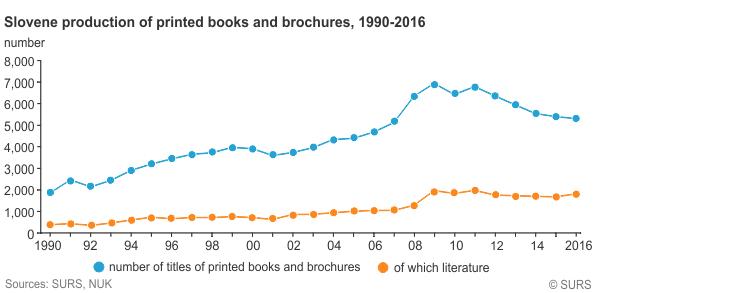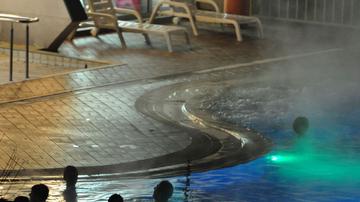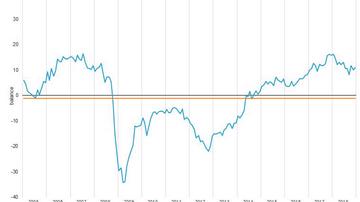


23 April was proclaimed the World Book and Copyright Day by UNESCO in 1995. 23 April 1616 is the day Miguel de Cervantes and William Shakespeare died.
Slovenia expanded the World Book Day into a literary festival called Slovenian Book Days.
Total book production in Slovenia has been declining since 2011
Book production in Slovenia was mostly growing between 1991 and 2011, except in 1992, 2000, 2001 and 2010: in 1990 1,853 and in 2009 almost four times as many (6,953) titles were issued. According to the National and University Library, after 2011 the production of printed books and brochures has been in decline; in 2016 5,319 titles were issued, 23.5% fewer than seven years before, when the number was record-high.
The share of literature is not declining
Over the past 26 years the trend of issuing works of literature has been similar to the trend regarding the total number of printed books, except that most literature was issued in 2011 (1,969) and not in 2009. In the 26-year period the share of literature was increasing: in 1991 it was 17.2% of all titles, next year it fell to 15.8% but after that it has been constantly growing. Of all book titles issued by publishers in Slovenia in 2016, 34% were titles of literature. The total number of titles is in decline, while the share of literature works is rising. In 2016 fewer titles were issued (5,319) than in 2015 (5,411), but the share of literature increased: in 2016 it was 34% (1,808 titles) and a year before 31% (1,668 titles).
Literature and film
Slovene film production started in 1905 with short documentaries. Of the 287 Slovene films produced after 1931 around 26% were based on literary works.
Female and male writers
Statistically speaking, writers are people writing books, scripts, storyboards, plays, essays, speeches, manuals, poems, fairy tales, reviews, etc. At the end of 2017, the Statistical Register of Employment included 296 people (five more than a year before) who performed this occupation as their principal occupation and participated in compulsory social insurance. For comparison, at present the Slovene Writers’ Association has 317 members.
Of the 296 formally employed writers at the end of 2017:
- 58% were female and 42% were male
- 29% were employed and 71% were self-employed
A more detailed breakdown for the 2012–2017 period shows that in 2012 around 33% of writers were employed and the rest were self-employed. In 2017 among employed writers there were 65% women and among self-employed there were 55% women. Approximately the same ratio was in the previous years.
On average every resident of Slovenia visits a general library five times a year
According to the National and University Library, there were 271 general libraries and 13 mobile libraries in Slovenia in 2016. For comparison, in 1991 there were 225 general libraries and 7 mobile libraries. General libraries had almost 470,000 members in 2016, while the number of visits exceeded 10 million for the first time in 2012. Library membership decreases over last ten years, but the number of visits per member increases: in 1991 each member visited the library on average 13 times and in 2016 22 times, which is five visits per resident per year.

































































